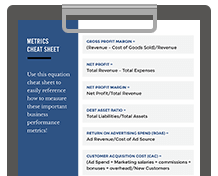11 Performance Metrics for Improving Business Operations
How do performance metrics produce more effective day-to-day operations? The solution is aggregating the right data and using it to create and enhance company processes and business operations.
Key business metrics for performance provide direction for future strategic growth.
The success of your company relies on the consistent reporting and evaluation of these metrics. The obvious and most important metrics for operations managers include revenue and profit and loss. But these are only a few of the things a savvy business owner should keep an eye on.
Regardless of your company’s size or specific goals, there are a series of key business performance metrics you should consider adding to your data arsenal.
They fall into the following three categories:
- Financials
- Marketing Outcomes
- Employee Performance

What are the most important business performance metrics to keep an eye on?
-
Financial Business Performance Metrics
There are endless key business metrics you can apply to the financial piece of your business. We recommend focusing on these four key things as a jumping off point:
- Gross Profit Margin
- Net Profit
- Net Profit Margin
- Debt Asset Ratio
1. Gross Profit Margin
Your gross profit margin provides a wealth of insight. It is a profitability ratio showing you how much of every dollar is left once you pay the cost of goods sold.
Determine your Gross Profit Margin using this equation:
Gross profit margin = (Revenue – Cost of Goods Sold)/Revenue
When compared around your industry, your gross profit margin can uncover if your company is pricing your goods and services competitively.
Your gross profit margin should be large enough to cover operating expenses.
Everything else is profit.
2. Net Profit
All profit is not created equally! Keeping a tight grasp on your company’s Net Profit ensures you know the true bottom line net earnings.
Determine your Net Profit using this equation:
Net profit = Total Revenue – Total Expenses
Net profit is found on the last line of the income statement, which is why it’s often referred to as the bottom line.
Stock prices revolve completely around this figure.
When Net Profit is low, it indicates much more than weak stock prices. Further data collection in all areas of business is necessary to determine the weak link(s) that contribute to the issue.
3. Net Profit Margin
According to InvestingAnswers.com, “Net profit margin is the percentage of revenue remaining after all operating expenses, interest, taxes and preferred stock dividends (but not common stock dividends) have been deducted from a company’s total revenue.”
Determine your Net Profit Margin using this equation:
Net profit margin = Net Profit/Total Revenue
Understand the percentage of revenue made it all the way to the bottom line by dividing net profit by total revenue. This key business metric is of utmost importance to owners, investors and shareholders.
The key here is turning sales into profits.
It is quite literally a percentage of sales and makes it easy to compare across the industry.
4. Debt Asset Ratio
If you have any debt on the business, the debt to asset ratio metric is important. It tells you the percentage of total assets that were financed and are now creating debt.
Determine your Debt Asset Ratio using this equation:
Debt Asset Ratio = Total Liabilities/Total Assets
The goal is to have as low a percentage as possible, indicating the the bulk of the company’s assets are owned by the shareholders and not the creditors.
Businesses operating effectively have debt payoff plans that dwindle the debt over time. Keeping a close eye on this metric helps ensure your payoff process is effective.
Now that you have financial business metrics under your belt, let’s look at a how to best measure marketing efforts.
Marketing Business Performance Metrics
With hundreds of metrics applicable in this piece of the puzzle, we will focus on the fundamental business performance metrics for improving business operations.
The metrics will vary depending on the kind of marketing your company does, so modify this list to fit your needs:
- Return on Advertising Spend
- Customer Acquisition Cost
- Time to Payback
- Marketing Originated Customer Percentage
5. Return on Advertising Spend (ROAS)
ROAS is often considered the most useful metric to evaluate the performance of marketing campaigns. It looks at every ad dollar spent, and determines the revenue earned.
The goal is having a deep understanding of profitable and unprofitable ad spends. ROAS is applied to specific campaigns and ad groups to shed light on performance.
Determine ROAS using this equation:
ROAS =
Ad Revenue/Cost of Ad Source
For example, if your company spent $3,000 on Google Adwords and earned $6,000 revenue directly from that campaign, the ROAS is $2.
6. Customer Acquisition Cost (CAC)
Often overlooked but so very important is the CAC metric. This is your total Sales and Marketing cost and it will shine a bright light on your marketing efficacy in it’s entirety.]
Determine CAC using this equation:
CAC =
(Ad Spend + Marketing salaries + commissions + bonuses + overhead)/New Customers
You will want to do this within a specific time period. For example, if you spend $100,000 on Sales and Marketing in 2016 and earned 200 customers, the CAC is $500 per customer.
7. Time to Payback
Although it has no fancy acronym, time to payback is especially relevant if your sales funnel is very long.
Note that there are industries where customers pay one time upfront and therefore this metric can be skipped.
For companies with monthly or annual payment structures, this is the number of months it takes you to earn back the CAC you spent to get a new customer.
So utilizing the example above, your new customer cost you $500.
How many months do they need to remain a customer before you earned back your $5,000? The industry goal is to keep Payback Time to under 12 months. In other words, becoming profitable within one year of customer acquisition ensures you begin making money quickly.
Determine Time to Payback using this equation:
Time to Payback =
CAC/Monthly Fees Paid -OR- CAC/Annual Fee
For example, your customer would need to pay ~$42/mo in order for you to become profitable after 12 months if your CAC is $500.
8. Marketing Originated Customer Percentage
The point of this business metric is to determine exactly what percentage of new customers were earned from marketing efforts.
It is different from CAC because it is looking at the total number of customers earned compared to the number of customers earned specifically through marketing.
There are a number of ways your company acquires customers without marketing, like referrals or walk-ins for example.
You will need a process in place to label all customers either marketing originated, or non-marketing originated.
Determine Marketing Originated Customer % using this equation:
Marketing Originated Customer Percentage =
(Total New Customers – Non-Marketing Originated)/Total New Customers
For example, if you earned 200 new customers, and 65 of them were non-marketing originated, you would divide 135/200 and have a 67.5% of marketing originated customers.
This number can then be compared to other marketing and financial metrics. Having the customer percentage helps determine the need for an increase or decrease in the marketing budget.
As mentioned, there are a slew of marketing metrics you can sink your teeth into on any given day. But when it comes to key business performance metrics, the four measurements above top our list.
Employee Business Performance Metrics
Aside from the ambitious solopreneur, every company of every size must include employee performance metrics if they want to use metrics to boost operations.
The success of a company often hinges on the consistent evaluation of employee performance, as the other key business metrics (financial, marketing) rely on employee effort.
Accurately evaluating your employees is based on a series of key business performance metrics:
- Employee Efficiency
- Quality of Work
- Adherence to Values
9. Employee Efficiency
Determining employee efficiency metrics means setting realistic, measurable goals.
Consider the following ways an employee can prove their efficiency:
- Maximizes productivity
- Minimizes cost
- Makes few mistakes
- Meets deadlines
There is no boiler plate equation for measuring this.
In short, it quantifies how much work is being accomplished. Compare efficiency to the cost of employment, and against other like-employees.
The best way to create in-depth evaluation is to have the employee prepare their goals in ways that can be measured in the future. This includes adding details like numbers and dates whenever possible.
Performance reviews or team assessments can be used to determine if these goals are met.
You can further measure employee efficiency metrics by gaining insight from managers, members from other teams that work closely with the person, and so on.
10. Quality of Work
You may be wondering why we only included quality and not quantity.
Quantity is inherently measured in the efficiency metric. Quantity without quality works against your business. Quality is in it’s own segment.
The actual work being produced is reviewed in order to determine true quality. Because this is subjective in most cases, creating a measurement process is crucial.
For example, an employee in a sales service position like insurance proves they do quality work by retaining clients.
For less specific roles, consider implementing a quality score that both the employee and their direct manager completes on a task-by-task basis.
Additionally, measuring work that is of sub-par quality can help provide an overview of the employee’s efforts. Here are some things you can quantify:
- Error rates
- Customer satisfaction levels
- The amount of work that must be redone
Individual performance is difficult to measure manually and talent management software has helped lift this burden.
11. Adherence to Values
Measuring how closely an employee follows the company’s values is a relevant metric in performance management.
Company values are put in place to create a culture and guide behavior. These values serve to shape abilities to make decisions and set goals.
These values intend to influence each and every employee in their daily efforts. Adhering to the values and embracing them as part of their corporate culture is key to growth and sustainability.
Like many employee related metrics, measuring adherence to company values will also be subjective.
The key is to ensure your company has clear, concisely defined core values. They must be easily understood and regularly shared.
Consider the following ways you can measure this:
- Include the core values on employee performance reviews and asking the employee to rate their adherence.
- Develop an employee of the month (or week) system that ranks based on adherence instead of solely performance.
- Ask managers to notify upper management or human resources if an employee is deviating from the values.
It’s a fact: analyzing business performance metrics can ensure better operations. As an owner or executive, your goal is to maximize profit.
Having the right metrics in place provides you with a consistent flow of data you can use to streamline effort and increase success.
While the process of developing these metrics can be a bit challenging, the positive outcome is worth it.
Use our outline to create the custom reporting structure for your business. With consistency and execution, you will see your business thrive.













